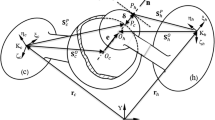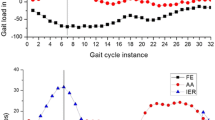Abstract
Numerous small scratches and some larger scratches have been observed on metallic femoral heads of explanted hip prostheses, with the larger scratches believed to be a major contributor to increased wear of the polyethylene acetabular cups. Previous work in our group has shown that smaller scratches, with a mean lip height up to 0.35 μm, can be caused by bone cement and bone particles up to 500 μm in size [1]. However, the larger scratches were not readily replicated with these particles. Therefore in this study experimental and theoretical models have been developed to investigate the damage caused by harder metallic and ceramic particles. Small 10 μm diameter spherical metallic particles were also found to produce small fine scratches on the metallic counterface. However larger diameter spherical metal particles greater than 100 μm in diameter, which were embedded in polyethylene pins, caused severe sharp scratching of the metallic counterface with scratch lips greater than 0.5 μm. This level of damage, which was comparable to the severe damage found in vivo, was also simulated by a three body finite element model. Thus the larger metal particles led to the type of damage which was predicted to increase wear dramatically. This technique for simulating severe in vivo third body damage using spherical metal particles was found to be reproducible and reliable and will be used in the future in hip simulator testing to replicate third body damage and wear.
Similar content being viewed by others
References
H. Minakawa, M. Stone, B. M. Wroblewski, M. Porter, E. Ingham and J. Fisher, in “44th Annual Meeting of the ORS”, (1998) p. 779.
L. Caravia, D. Dowson, F. Fisher and B. Jobbins, J. of Engineering in Medicine 204H (1990) 65.
G. H. Issac, J. R. Atkinson, D. Dowson, P. D. Kennedy and M. R. Smith, Eng. Med. 16(3) (1987) 167.
C. M. Mcnie, D. C. Barton, E. Ingham, M. H. Stone, J. L. Tipper and J. Fisher, J. Mat. Sci.: Mat. Med., in press (1998).
J. Fisher, P. Firkins, E. A. Reeves, J. L. Hailey and G. H. Issac, J. of Eng. in Medicine. 209H (1995) 263.
D. L. Shardlow, T. Green, J. B. Matthews, M. Wroblewski, M. H. Stone and J. Fisher, “8th Annual conference of EORS” (1998) p. 062.
M. Jasty, C. Bragdon, K. Lee, A. Hanson and W. Harris, J.B.J.S. 76-B(1) (1994) 73.
HIBBET, KARLSSON, SORENSEN, INC., ABAQUS, Standard/ User's Manual, Version 5.6, (1996).
J. Jiang, F. Sheng and F. Ren, Wear 217 (1998) 35.
Author information
Authors and Affiliations
Rights and permissions
About this article
Cite this article
Mcnie, C.M., Barton, D.C., Fisher, J. et al. Modeling of damage to articulating surfaces by third body particles in total joint replacements. Journal of Materials Science: Materials in Medicine 11, 569–578 (2000). https://doi.org/10.1023/A:1008928219843
Issue Date:
DOI: https://doi.org/10.1023/A:1008928219843




